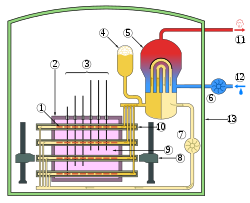CANDU reactor
The "Scots" that wis uised in this airticle wis written bi a body that haesna a guid grip on the leid. Please mak this airticle mair better gin ye can. |
The CANDU, for Canada Deuterium Uranium, is a Canadian pressurized heavy-water reactor design used tae generate electric pouer. The acronym refers tae its deuterium oxide (hivy watter) moderator and its use o (originally, natural) uranium fuel. CANDU reactors were first developed in the late 1950s an 1960s bi a partnership atween Atomic Energy of Canada Limited (AECL), the Hydro-Electric Power Commission of Ontario, Canadian General Electric, an other companies.

- Fuel bundle
- Calandria (reactor core)
- Adjuster rods
- Heavy-water pressure reservoir
- Steam generator
- Light-water pump
- Heavy-water pump
- Fueling machines
- Heavy-water moderator
- Pressure tube
- Steam going to steam turbine
- Cold water returning from turbine
- Containment building made of reinforced concrete
There have been two major types o CANDU reactors, the original design o around 500 MWe that was intended tae be used in multi-reactor installations in muckle plants, an the rationalized CANDU 6 in the 600 MWe class that is designed tae be used in single stand-alone units or in small multi-unit plants. CANDU 6 units were built in Quebec an New Brunswick, as well as Pakistan, Argentinae, Sooth Korea, Romanie, an Cheenae. A single example of a non-CANDU 6 design was sold to Indie. The multi-unit design was used only in Ontario, Canada, an grew in size an pouer as more units were installed in the province, reaching ~880 MWe in the units installed at the Darlington Nuclear Generating Station. An effort to rationalize the muckler units in a fashion similar tae CANDU 6 led tae the CANDU 9.
By the early 2000s, sales prospects for the original CANDU designs were dwindling due tae the introduction o newer designs from other companies. AECL responded bi cancelling CANDU 9 development an movin tae the Advanced CANDU reactor (ACR) design. ACR failed tae find any buyers. Its last potential sale was for an expansion at Darlington, but this was cancelled in 2009. In October 2011, the Canadian Federal Government licensed the CANDU design tae Candu Energy (a wholly owned subsidiary of SNC-Lavalin), which also acquired the former reactor development an marketing division o AECL at that time. Candu Energy offers support services for existing sites an is completing formerly stalled installations in Romanie and Argentinae through a partnership with China National Nuclear Corporation. SNC Lavalin, the successor to AECL, is pursuing new Candu 6 reactor sales in Argentina (Atucha 3), as well as Cheenae an Breetain. Sales effort for the ACR reactor has ended.